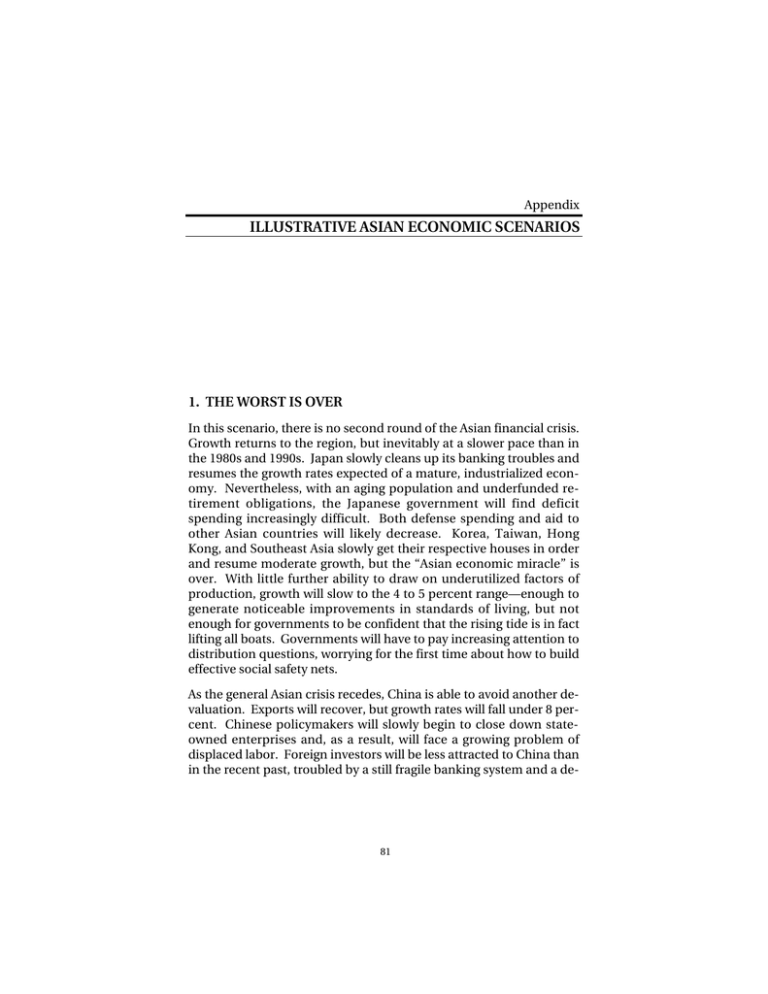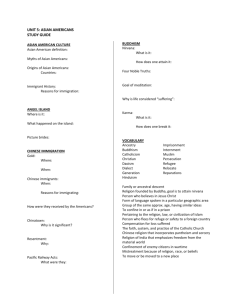ILLUSTRATIVE ASIAN ECONOMIC SCENARIOS 1. THE WORST IS OVER
advertisement

Appendix ILLUSTRATIVE ASIAN ECONOMIC SCENARIOS 1. THE WORST IS OVER In this scenario, there is no second round of the Asian financial crisis. Growth returns to the region, but inevitably at a slower pace than in the 1980s and 1990s. Japan slowly cleans up its banking troubles and resumes the growth rates expected of a mature, industrialized economy. Nevertheless, with an aging population and underfunded retirement obligations, the Japanese government will find deficit spending increasingly difficult. Both defense spending and aid to other Asian countries will likely decrease. Korea, Taiwan, Hong Kong, and Southeast Asia slowly get their respective houses in order and resume moderate growth, but the “Asian economic miracle” is over. With little further ability to draw on underutilized factors of production, growth will slow to the 4 to 5 percent range—enough to generate noticeable improvements in standards of living, but not enough for governments to be confident that the rising tide is in fact lifting all boats. Governments will have to pay increasing attention to distribution questions, worrying for the first time about how to build effective social safety nets. As the general Asian crisis recedes, China is able to avoid another devaluation. Exports will recover, but growth rates will fall under 8 percent. Chinese policymakers will slowly begin to close down stateowned enterprises and, as a result, will face a growing problem of displaced labor. Foreign investors will be less attracted to China than in the recent past, troubled by a still fragile banking system and a de- 81 82 The Role of Southeast Asia in U.S. Strategy Toward China gree of transparency in financial matters that lags considerably behind improving international practice. In this scenario, the attention of Asian policymakers will be focused principally on domestic concerns. These policymakers will have little attention and fewer resources to spare for regional initiatives. Trade liberalization will proceed slowly in the Asia Pacific Economic Cooperation (APEC) framework. There will be occasional small-scale crises, as one or another country hits bumps on the road to recovery. Without prospects of a meaningful regional response, countries that get into trouble will continue to look to international financial institutions for assistance when needed. U.S. economic policy in the region will focus on making progress on trade liberalization and encouraging Asian countries to stick with the “Washington consensus” of free trade and capital movements, privatization, deregulation, and fiscal and monetary restraint. But U.S. efforts will be mostly exhortation and leading by example; little material assistance will be forthcoming. 2. FURTHER DETERIORATION—CHINA BECOMES THE LATEST VICTIM OF THE ASIAN CRISIS This scenario assumes further economic deterioration and is the most unpredictable scenario with regard to the modalities it might take. The scenario could come about if continued malaise in Japan and the rest of Asia further depresses Chinese exports. Fears of a Chinese devaluation encourage capital flight. Chinese growth falls below the rates required to maintain employment in all parts of the country. China devalues its currency, hoping that a one-time devaluation will be sufficient to restore export competitiveness and to discourage further capital flight. Southeast and South Asian countries that compete with China are hard hit. Fragile recoveries are aborted and some of the affected countries respond with currency devaluations. Financial uncertainty again sweeps the region. As in the 1930s, this has profound political and regional security consequences. Within the region, there will be an increase in civil unrest and some of the more fragile governments will face threats to their survival. In official and commercial circles, there will be considerable resentment of China for touching off an- Illustrative Asian Economic Scenarios 83 other round of competitive devaluations. Relations between China and other Asian nations will come to be dominated by bickering over trade matters, illegal immigration, and possibly the treatment of the overseas Chinese communities. In China, a sharp decline in economic performance could threaten the viability of the country’s banking system, sharpen regional differences, and possibly bring into question the legitimacy of the regime. The role of the People’s Liberation Army in the polity will grow. There could be power shifts within the military, with significant consequences for foreign and security policy decisions. In this scenario, with Korea and Japan mired in their own economic problems, the United States will be the only country capable of exercising leadership. Risks and opportunities for the United States will be high. Both U.S. influence and demands on U.S. capabilities—in the political, economic, and military spheres—will grow. U.S. influence will be limited only to the quality of U.S. leadership and the strength of the U.S. commitment to the region. 3. CHINA DODGES THE BULLET China somehow manages to get its house in order. It begins to make progress in reforming state-owned enterprises; it gains real control over International Trade and Investment Corporations (ITICs); and it begins to reform its banking system. Japan, on the other hand, continues to muddle through without breaking out of its economic paralysis. Without the Japanese locomotive to pull the train, other Asian economies cannot mount sustained recoveries. Within Southeast Asia, there is greater differentiation in economic performance, depending on the individual countries’ ability to maintain political stability and appropriate economic and fiscal policies. A newly confident China begins to play a larger role in Asian economic affairs, mobilizing its large foreign currency reserves to assist other Asian countries whose currencies come under attack. There will be greater opportunities for the expansion of Chinese influence and lesser ability on the part of regional states to balance it. The United States finds itself in an uneasy alignment with China in trying to stabilize the Asian economies. Beijing continues to point 84 The Role of Southeast Asia in U.S. Strategy Toward China out that maintenance of the value of the yuan is not without cost to China. Chinese officials declare that China will stay the course for the good of the region, as long as other countries do not try to take unfair advantage of China’s forbearance. China becomes more assertive as to what constitutes unfair advantage and the sort of policies it finds unacceptable. Increased consultation and even coordination with the United States and the international financial institutions would be helpful in this regard. 4. THE REST OF ASIA RECOVERS, BUT CHINA FALTERS This scenario is the reverse of Scenario 3. Japan takes credible steps to revitalize its banking system and resume higher rates of economic growth. The Southeast Asian economies begin to recover, but China fails to deal with its structural problems in the banking and state industrial sectors. As in Scenario 2, an economic crisis in China would have significant and unpredictable consequences. There are several paths that Beijing could take in these circumstances. It could: • Turn inward and concentrate on resolving its internal difficulties—through processes of either liberalization or repression. • Pursue foreign adventures in hopes of generating domestic unity. In this subscenario, Taiwan could be a flashpoint. The PRC could also become more assertive in pressing its claims to the South China Sea, or it could take up the defense of beleaguered ethnic Chinese communities in Southeast Asia. • Or China may be unable to maintain domestic stability and it could enter a period of increased turmoil and even civil war. In this subscenario, Beijing would face increased separatist challenges in Xinjiang and Tibet. Taiwan might see this as a window of opportunity to assert its independence.





